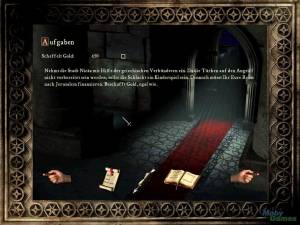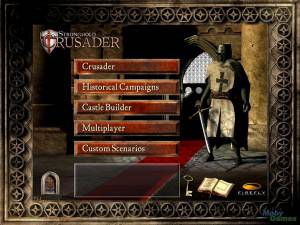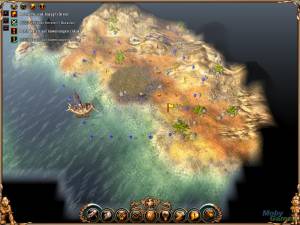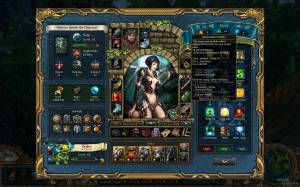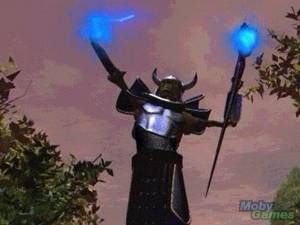Game Classification
The Settlers 7: Paths to a Kingdom Blue Byte Studio GmbH, Ubisoft Entertainment SA, 2010
Classification
VIDEO GAMEKeywords
Market
This title is used by the following domains:- Entertainment
Audience
This title targets the following audience:Age : 12 to 16 years old / 17 to 25 years old
General Public
Gameplay
The gameplay of this title is Game-based(designed with stated goals)
The core of gameplay is defined by the rules below:
Similar games
 Tandrien has a problem: The evil Lord Wolvering is conquering the land and no one seems to be able to stop him. No one? Of course not. Princess Zoé is tasked by her father to stop the Lord and once again reunite the country under one crown. And Zoé does as she's told - but not for the good of the people. Instead she finally wants to become a Queen herself. The resulting peace is just a bonus.
Tandrien has a problem: The evil Lord Wolvering is conquering the land and no one seems to be able to stop him. No one? Of course not. Princess Zoé is tasked by her father to stop the Lord and once again reunite the country under one crown. And Zoé does as she's told - but not for the good of the people. Instead she finally wants to become a Queen herself. The resulting peace is just a bonus.
As opposed to the previous two, more RTS-oriented iterations of the series, The Settlers 7: Paths to a Kingdom returns in its core to the gameplay mechanics of the very successful second part of the series, The Settlers II: Veni, Vidi, Vici. Still, the game features several deviations and changes to the original gameplay mechanics and is very much multiplayer-oriented. Even the 12 mission long single player campaign, in which the player helps Zoé reunite Tandrien, is more of a really long tutorial for the multiplayer-matches, slowly introducing the players to the game.
The player once again starts with an almost empty sector, only containing a castle, a warehouse, a construction building and a tavern. The latter is used to recruit soldiers and additional generals in exchange for gold and foot. As opposed to the starting general, recruited generals give additional bonuses like an advantage against defense towers. But before the player needs to thing about that, he needs to start building up a working economy with the resources he has available in his castle and the ones he can find in his first sector. As most parts of the series, this involves building production cycles like placing a lumberjack near a forest to cut wood, building a sawmill to produce planks out of it and using those planks to build other buildings and production lines. In addition a forester can keep the forest from vanishing. But instead of placing each production building individually, the player now only places one of six main types of buildings and adds on up to three production facilities to it. For example the apartment building not only increases the population limit, but is also required to build a butcher or a tailor. Although this allows the player to build entire production cycles on a small strip of land, the workers in the buildings won't bring their wares directly to the next in line. Instead they get their resources from the nearest warehouse and bring their product there themselves. And in order to do that, once again walkways need to be build, connecting each building.
Once the economy is stable and the wares keep flowing, its a good idea to build a higher level structure including the barracks, the church and the trading guild. These are required to build the corresponding units as well as to get fast access to prestige-points. These prestige points are invested into a small prestige tree which in turn first unlocks access to these higher level structures and then allows the player to upgrade these buildings to get be able to build higher level units or gain the ability to upgrade his streets for faster travel or his defenses to make it harder for the enemy to get inside and destroy the castle (the ultimate victory condition).
Back in the day, destroying the enemy castle was the only way to win a game. Now its the most cumbersome way. Instead the players compete for victory points. These are earned for certain milestones like having more than 25 settlers, by fulfilling quests for neutral NPCs on the map, capturing specific sectors on the map and several more. The clue: most of these victory points can be reclaimed by an enemy player if he manages to best the other player currently holding the victory point e.g. by having a settler more.
Basically there are now always three ways the player can accomplish a task. For example in order to expand his territory and get access to additional resources, there's for one the usual military way, building a huge army and just conquering it. The second way is religion. By building monks, the player can convince the current owner of a sector to give up his land without any fighting. The third way is bribing the neutral NPCs with gold, again gaining control over sectors without any fighting.
The game also features several different maps. If the player zooms all the way out, he'll see the sector map, showing how each sector is connected, where all the armies are and where all the resources are. Then there's the trade-route-map, on which the players unlock additional trading opportunities and can even gain a victory point but unlocking a specific trade-route. The third map is the tech-tree which again offers upgrades for each of the three play-styles. Techs and trade-routes can only be unlocked by one player at a time, adding another layer of competition to the game. As it takes time for the players monks to reach the library on the map in order to research a tech, his enemy can send more monks to take it from him during that time.
Besides the single player campaign, the game offers skirmishes against AI-enemies and a multiplayer for up to four players. It features a ranking system in which the player's avatar levels up by winning matches and by doing so unlocks specials including new AI-enemies, new maps and additional castle-pieces. The latter are used to customize the player's headquarter or build a completely new one from scratch. Also available is a limited map-editor allowing the player to change victory conditions, the location of sectors and other options but not actually the layout of the map. [source:mobygames]
Distribution : Retail - Commercial
Platform(s) : Macintosh - PC (Windows)
 Français
Français English
English








